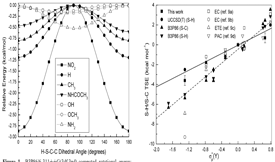
Effect of Ring Substitution on the S-H Bond Dissociation Enthalpies of Thiophenols. An Experimental and Computational Study
J. Phys. Chem. A 2006, 110, 9949-9958. DOI: 10.1021/jp062781h
Abstract
There are conflicting reports on the origin of the effect of Y substituents on the S−H bond dissociation enthalpies (BDEs) in 4-Y-substituted thiophenols, 4-YC6H4S−H. The differences in S−H BDEs, [4-YC6H4S−H] − [C6H5S−H], are known as the total (de)stabilization enthalpies, TSEs, where TSE = RSE − MSE, i.e., the radical (de)stabilization enthalpy minus the molecule (de)stabilization enthalpy. The effects of 4-Y substituents on the S−H BDEs in thiophenols and on the S−C BDEs in phenyl thioethers are expected to be almost identical. Some S−C TSEs were therefore derived from the rates of homolyses of a few 4-Y-substituted phenyl benzyl sulfides, 4-YC6H4S−CH2C6H5, in the hydrogen donor solvent 9,10-dihydroanthracene. These TSEs were found to be −3.6 ± 0.5 (Y = NH2), −1.8 ± 0.5 (CH3O), 0 (H), and 0.7 ± 0.5 (CN) kcal mol-1. The MSEs of 4-YC6H4SCH2C6H5 have also been derived from the results of combustion calorimetry, Calvet-drop calorimetry, and computational chemistry (B3LYP/6-311+G(d,p)). The MSEs of these thioethers were −0.6 ± 1.1 (NH2), −0.4 ± 1.1 (CH3O), 0 (H), −0.3 ± 1.3 (CN), and −0.8 ± 1.5 (COCH3) kcal mol-1. Although all the enthalpic data are rather small, it is concluded that the TSEs in 4-YC6H4SH are largely governed by the RSEs, a somewhat surprising conclusion in view of the experimental fact that the unpaired electron in C6H5S• is mainly localized on the S. The TSEs, RSEs, and MSEs have also been computed for a much larger series of 4-YC6H4SH and 4-YC6H4SCH3 compounds by using a B3P86 methology and have further confirmed that the S−H/S−CH3 TSEs are dominated by the RSEs. Good linear correlations were obtained for TSE = ρ+σp+(Y), with ρ+ (kcal mol-1) = 3.5 (S−H) and 3.9 (S−CH3). It is also concluded that the SH substituent is a rather strong electron donor with a σp+(SH) of −0.60, and that the literature value of −0.03 is in error. In addition, the SH rotational barriers in 4-YC6H4SH have been computed and it has been found that for strong electron donating (ED) Ys, such as NH2, the lowest energy conformer has the S−H bond oriented perpendicular to the aromatic ring plane. In this orientation the SH becomes an electron withdrawing (EW) group. Thus, although the OH group in phenols is always in-plane and ED irrespective of the nature of the 4-Y substituent, in thiophenols the SH switches from being an ED group with EW and weak ED 4-Ys, to being an EW group for strong ED 4-Ys.
Return Previous Next